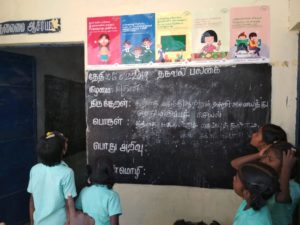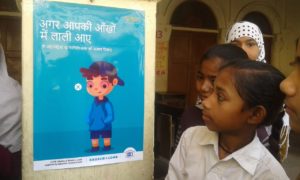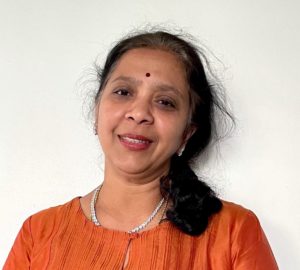March 15, 2022
By Lakshmi Shinde, MSc Optom, FAAO, FBCLA, FIACLE, CEO, Optometry Council of India
As the OCI continues to educate ECPs and consumers about myopia, the available treatments, and the risks of untreated myopia, we hope to continue expanding our organization and connecting with optometrists throughout India.

The OCI works to educate children about the risks of spending too much time with devices or doing near work.
For the last decade, the Optometry Council of India (OCI) has been working to establish uniform education and practice standards to support more than 42,000 eye care practitioners across the continent. ECPs throughout India have struggled to receive the same level of assistance and regulation that other health care professionals receive. OCI has provided that representation to government officials and offered continuing education sessions for practitioners.
In March 2021, the Government of India passed the National Commission for Allied and Health Professionals (NCAHP) Act, which regulates optometry as a profession among several other health and allied professions. OCI plans to work with the government to implement the NCAHP Act appropriately.
Many of the organization’s goals are now geared toward myopia management. OCI plans to spread awareness and continue to educate consumers, lawmakers, and ECPs on the modalities currently available in India and the risks of untreated myopia.
Myopia Management in India
Historically in India, spectacles have been prescribed for those with myopia. With the advent of orthokeratology and soft multifocal contact lenses, practitioners have opted for these modalities, though options for OrthoK are very limited, but slowly the access of these lenses to practitioners is increasing. Although low-dose atropine is available for treatment, optometrists cannot prescribe it. However, few novel spectacle lens options are available in India that the practitioners can prescribe for myopia control.
The two most significant challenges practitioners in India face are awareness of myopia and the affordability of myopia management treatments. If a parent walks into the optometrist’s office with a child diagnosed with myopia, our job is to educate them about myopia, the probability of the child’s myopia progressing, and the dangers associated with myopic progression. The other huge challenge is educating the economically underprivileged about myopia. This community gets support from the government, NGOs, and organizations such as the OCI, who perform eye-screenings, examine them for refractive error and other ailments, and provide free or subsidized traditional single vision spectacles. However, affordability of options for controlling myopia is a hurdle for all consumers in India. Contact lens corrective options for myopia are expensive, and our health coverage doesn’t cover these myopia management treatments.
Spreading Awareness of Myopia Management
The OCI currently has four main goals related to myopia management:
- Increase awareness among the public.
- Increase educational sessions for optometrists through CE programs.
- Liaise with industry that has a stake in myopia management and conduct training programs.
- Develop materials that are user friendly and easy to understand by consumers, which will be distributed to optometrists.
To help make these goals a reality, we’ve created a Myopia Task Force within OCI. My fellow members of the task force include Dr. N Anuradha, Dr. Dharani Ramurthy, Dr. Jameel Rizwana Hussaindeen, Dr. Pavan Verkicharla, Dr. Viswanath S, and Mr. Yeshwant Saoji. As a group, our first primary effort was to publish a Myopia White Paper, which has been submitted to the Ministry of Higher Education. The members of the myopia task force formulated the document based on evidence regarding sunlight and myopia currently available internationally. They also reviewed the incidence of myopia and the pathology associated with high myopia in India. They then made recommendations based on the evidence that was uncovered. In the paper, we made several key recommendations, including:
- A compulsory 60-minute break outdoors in all schools in India. This will help increase exposure to sunlight.
- In the case of online education, 20-minute breaks between sessions.
- Reduce assignments and near work for preschool children; learning needs to be more activity based.
- Awareness at the parent and teacher level regarding myopia and the long-term consequences of myopia.
- All schoolchildren should receive regular eye screenings.

To spread awareness about the risks of untreated myopia, the OCI has educational materials targeted specifically to children.
The Myopia Task Force has also discussed the best ways to pass on information about myopia to the public. Specifically, we’re concerned with how much time children spend indoors and in front of screens. Since the start of the COVID-19 pandemic, children have spent less time outdoors and more time engaging in activities that involve devices. We want to ensure that consumers receive messages about the dangers of long-term eye health linked to indoor time and near work on devices.
To get the message out, we collectively decided to make a short video to be shared by eye care professionals to quickly get the attention of parents. Hoya Vision Care India sponsored the video, which featured our Myopia Task Force members and other leading experts sharing essential information about childhood myopia. The video emphasizes the importance of yearly eye exams, protecting children’s long-term eye health, and how current myopia management modalities can keep children safe from serious eye health risks.
Once the video was made, our goal was to ensure that the release had maximum impact. To officially launch the video, Transport and Roadways Minister Honorable Nitin Gadkari announced the film. The video has now been uploaded to OCI’s YouTube channel, and we proudly share it with anyone interested. Currently, OCI is working with schools throughout India to have the video shown to children; however, the pandemic has slowed those efforts.
Connecting with Eye Care Professionals
Following the Myopia White Paper and the release of our video, the OCI Myopia Task Force continues to take steps toward spreading awareness of myopia management throughout India. Presently, the Myopia Task Force is developing CE about myopia education for optometrists. We are also developing materials about myopia management that we can share with the general public. Additionally, the Myopia Task Force, as a futuristic strategy, aims at collecting data regarding myopia and myopia research from all across India to develop and publish Indian data.
As we continue to educate ECPs and consumers about myopia, the available treatments, and the risks of untreated myopia, we hope to continue expanding our organization and connecting with optometrists throughout India.
 |
Lakshmi Shinde graduated from Elite School of Optometry, Chennai, India, in 1991, and she completed her Masters in Optometry from the University of New South Wales. She has since been associated with the International Association of Contact Lens Educators, and she is presently the Executive Manager, Global Education. She has also received the prestigious American Academy award for her contribution to international optometry, and the Optometrist of the Year award from Sankara Nethralaya in 2016. She is the CEO of the Optometry Council of India (OCI), and she shares an optometry practice with her husband where her area of interest is specialty contact lens fitting. |













